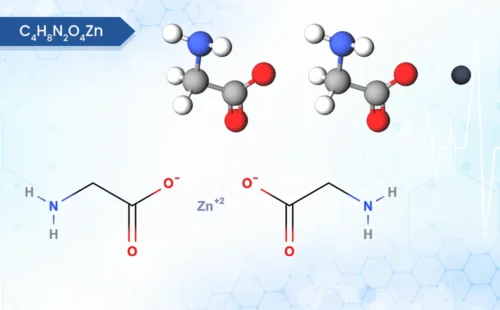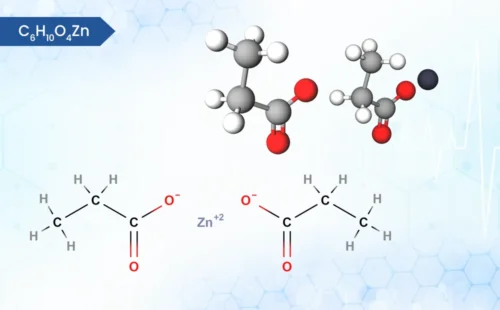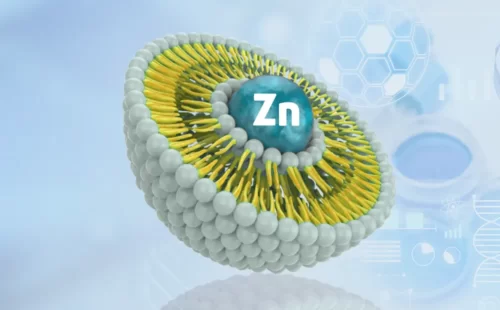Zinc Acetate
-
Product Name:
Zinc Acetate
-
Molecular Formula:
C4H6O4Zn
-
Molecular Weight:
183.5 g/mol
-
CAS No.:
29152910
-
HSN Code:
29152910
-
CID Code:
11192
-
Shelf Life:
3 years - 20°C powder
-
ATC Code (WHO)
A16AX05
-
ChemSpider ID
10719
-
UNII No.
H2ZEY72PME
- USP
- IUPAC Names
- Synonyms
- MSDS
USP of Zinc Acetate
- Zinc acetate is best known for its potential to reduce the duration and severity of cold symptoms when used as a lozenge and is also used as a dietary supplement to address zinc deficiencies.
- Zinc acetate is used as a food additive, primarily as a flavoring agent. It can enhance the taste and aroma of certain foods and beverages.
IUPAC Names of Zinc Acetate
zinc;diacetate
Synonyms of Zinc Acetate
- Zinc Acetate
- 557-34-6
- Zinc diacetate
- Zinc(II) acetate
- Dicarbomethoxyzinc
- Acetic acid, Zinc salt
- Acetic acid, Zinc(II) salt
MSDS of Zinc Acetate
Download MSDS PDFFirst Aid Measures
- General advice: Consult a physician. Show this safety data sheet to the doctor in attendance.
- If inhaled: If breathed in, move person into fresh air. If not breathing, give artificial respiration. Consult a physician.
- In case of skin contact: Wash off with soap and plenty of water. Consult a physician.
- In case of eye contact: Rinse thoroughly with plenty of water for at least 15 minutes and consult a physician.
- If swallowed: Never give anything by mouth to an unconscious person. Rinse mouth with water. Consult a physician.
- Most important symptoms and effects, both acute and delayed: The most important known symptoms and effects are described in the labelling (see section 2.2) and/or in section 11
- Indication of any immediate medical attention and special treatment needed: No data available
Fire-Fighting Measures
- Suitable extinguishing media: Use water spray, alcohol-resistant foam, dry chemical or carbon dioxide.
- Special hazards arising from the substance or mixture: Carbon oxides, Zinc/zinc oxides
- Advice for firefighters: Wear self-contained breathing apparatus for firefighting if necessary.
- Further information: no data available
Exposure Controls / Personal Protection
- Control parameters: Components with workplace control parameters
- Appropriate engineering controls: Handle in accordance with good industrial hygiene and safety practice. Wash hands before breaks and at the end of workday.
- Eye/face protection: Safety glasses with side-shields conforming to EN166 Use equipment for eye protection tested and approved under appropriate government standards such as NIOSH (US) or EN 166(EU).
- Skin protection: Handle with gloves. Gloves must be inspected prior to use. Use proper glove removal technique (Without touching glove’s outer surface) to avoid skin contact with this product. Dispose of contaminated gloves after use in accordance with applicable laws and good laboratory practices. Wash and dry hands. The selected protective gloves have to satisfy the specifications of EU Directive 89/686/EEC and the standard EN 374 derived from it.
- Body Protection: Complete suit protecting against chemicals, The type of protective equipment must be selected according to the concentration and amount of the dangerous substance at the specific workplace.
- Respiratory protection: For nuisance exposures use type P95 (US) or type P1 (EU EN 143) particle respirator. For higher level protection use type OV/AG/P99 (US) or type ABEK-P2 (EU EN 143) respirator cartridges. Use respirators and components tested and approved under appropriate government standards such as NIOSH (US) or CEN (EU).
- Control of environmental exposure: Prevent further leakage or spillage if safe to do so. Do not let product enter drains. Discharge into the environment must be avoided.
Physical and Chemical Properties
- Appearance Form: Crystalline or Granules
- Color: White
- Odour: Slight acetous Odour
- pH (5% w/v): 6.00 – 8.0
- Melting point/freezing point: 237 °C
- Initial boiling point and boiling range: no data available
- Sublimation Temperature: no data available
- Density: no data available
- Vapour pressure: no data available
- Vapour density: no data available
- Refractive density: 1,840 g/cm3
- Water solubility: Freely soluble in water
- Decomposition temperature: no data available
- Viscosity: no data available
- Other safety information: No data available

If you are interested on Zinc Acetate, then
Description of Zinc Acetate
Zinc acetate is a white crystalline powder with molecular formula Zn(CH3COO)2 that is often found in it dehydrate form, meaning it contains two molecules of water in its crystal structure.
Application of Zinc Acetate
- Used in lozenges and oral supplements to help reduce the severity and duration of common cold symptoms when taken at the onset of illness.
- Serves as a catalyst or reagent in various chemical reactions, particularly in organic synthesis, to facilitate the formation of specific compounds.
- In the textile industry, it is used as a mordant in dyeing processes to help fix dyes to fabrics and improve colorfastness.
Click now to learn more about Zinc Acetate in easy-to-digest articles.
If you are interested on Zinc Acetate, then
Related Products
Related Blogs of Zinc Acetate

Zinc Acetate Commonly occurring as the dihydrate Zn(CH3CO2)2•2H2O, zinc acetate is a salt that has the chemical formula of Zn(CH3CO2)2.…...

What is Zinc Citrate? Produced by complete neutralization of psychiatric acid with the highly pure zinc source, subsequent precipitation, and…...








